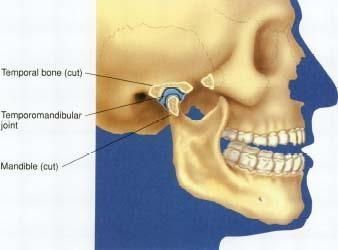Temporomandibular Disorder
TEMPOROMANDIBULAR DISORDER (TMD)
TMD is made up of several disorders that affect the jaw joint and the muscles that control chewing. TMD’s occur as a result of problems with the jaw, jaw joint and the surrounding facial muscles that control chewing and moving the jaw. The disorder can be as minor as slight clicking or popping sensations when the mouth is opened or closed, or as serious as chronic pain extending into the face, neck and shoulders.
UNDERSTANDING THE TEMPOROMANDIBULAR JOINT (TMJ)
The TMJ is the hinge joint that connects the lower jaw (the mandible) to the temporal bone of the skull, located immediately in front of the ear on each side of your head. These are flexible joints and allow the jaw to move up and down and side to side, enabling you to talk, chew and yawn. Muscles that are attached to and surrounding the jaw joint control the movement and position of the jaw.

WHAT CAUSES TMD?
The exact cause of TMD is unclear, but dentists believe that the symptoms arise from problems with the muscles of the jaw, or with the parts of the joint.
Factors that can contribute to TMD include:
- head trauma
- head or neck injuries (whiplash injury)
- lost teeth
- arthritis in the jaw joint
- misaligned or unstable bite (unstable occlusion)
- jaw muscles working improperly
- grinding or clenching of the teeth
- stress (mental or physical)
- dislocation of the disc in the jaw joint
WHAT ARE SYMPTOMS OF TMD?
Patients with TMD can present with a range of symptoms, and these symptoms can be temporary or last for many years. TMD has show to affect women more frequently than men.
Symptoms of TMD include:
- tenderness in the jaw area, in/around the ear, or in the neck/shoulders
- clicking or popping noises when opening or closing your mouth
- limited or painful opening of your mouth
- jaw gets “locked” either open or closed
- ringing or stuffy feeling in ears
- frequent headaches
- jaw muscles feel tired
- difficulty chewing or bite feels as if teeth do not fit together properly
- swelling in the side of your face
- tooth pain
HOW IS TMD DIAGNOSED?
Your dentist will conduct a thorough patient history and dental exam, to determine the cause(s) of your symptoms. Sometimes the dentist will also use x-rays, MRI’s and/or CT scans to further analyze your jaw joint.
HOW IS TMD TREATED?
There is a wide range of treatments for TMD, depending on the cause and how severe and frequent the symptoms are. They can range from self-care, “at home”, treatments, to injections and surgeries. Ideally, we prefer to start with the more conservative, non-surgical treatments, with TMJ surgery being used as a last resort treatment.
Short-term treatments can include:
- prescription and nonprescription ant inflammatory, pain or muscle relaxant medications
- ice packs or heat packs
- eating a softer diet
- cut food into small pieces
- avoid chewing on hard foods
- avoid “repetitive chewing” such as chewing gum
- muscle stretching exercises
If it is determined that the TMD symptoms are due to you grinding your teeth or due to you having a “deep bite” then the ideal treatment may be a type of custom made jaw splint. This splint is made to help reposition the mandible to a more relaxed position, which in turn helps to reduce the tension in the jaw joint and associated muscles, thus reducing the severity and frequency of the TMD symptoms.
If the symptoms are determined to be due to missing some teeth or due to a misaligned or unstable bite, then the ideal treatment is to replace the missing teeth and making crowns or doing orthodontic treatment to gain a more ideal position of the teeth.
In rare cases, surgery may be required to treat a TMD. Surgery is the last resort treatment, and is a viable option after other forms of treatment have been tried unsuccessfully.
At our office, we provide a wide range of treatment options for TMD, including the following:
- bite adjustment
- custom mouth guards
- custom jaw splints
- prescription medication (if indicated)
- replace missing teeth
- restore an unstable bite with crowns and restorative work or with orthodontic work
If you experience any of the above symptoms or think you may have a TMD, contact our office for more information.





